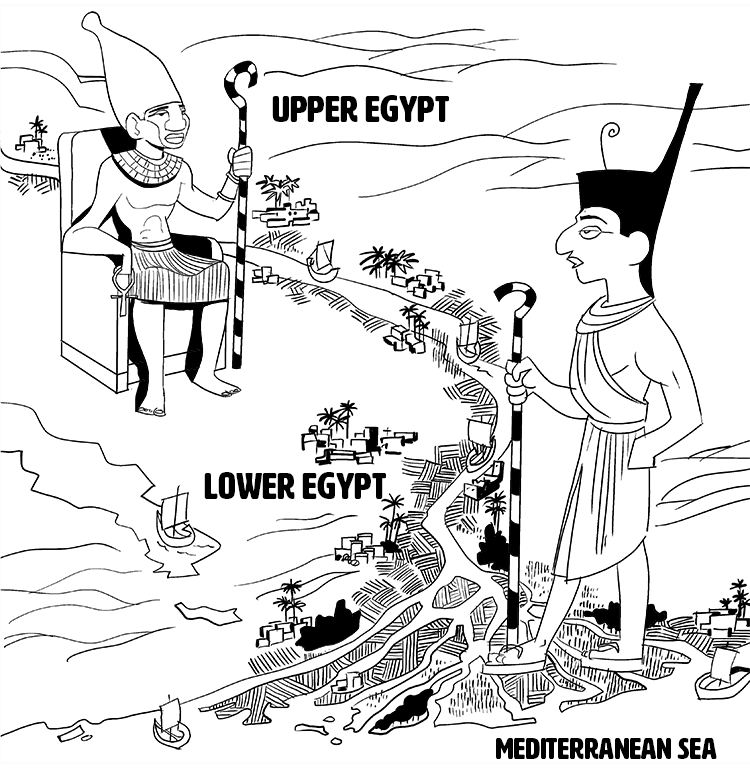For most of Egyptian history, Egypt has operated as one political unit. But within this tight package of a nation is a more complex story, one of two distinct lands coming together and rising up to dominate the ancient world.
Predynastic Egypt
Civilization in Egypt is old. Really old. We’re talking like 6,000 years, which makes Egypt one of the first settled societies in the world. But civilization in Egypt did not develop just in one place. Instead, it emerged in two distinct regions, which we now call Upper and Lower Egypt.
Lower Egypt is the area surrounding the Nile River Delta. It includes important cities such as Memphis (unified Egypt’s first capital), Alexandria (founded much, much later by “Alexander” the Great…get it?), Avaris, and Sais.
Upper Egypt is the part of Egypt that extends south of the Nile Delta. It’s northern boundary shifts depending on the time period and the source, but it’s generally considered to be just south of Memphis, which is not too far from modern-day Cairo. The two most important cities in this region were Thebes and Herakleopolis. The southern border of Upper Egypt is typically considered to be Aswan, an important trading hub in southern Egypt. But this line might shift depending on the era of Egyptian history, for Kush was a frequent target of Egyptian imperial ambitions.
If you look at a map of Egypt, you might think the mapmaker was standing on their head when assigning names to these two regions. Lower Egypt is to the north, which makes it look like it’s “on top.”
But the names don’t come from cardinal directions. Instead, they reflect the flow of the River Nile, which runs from the highlands in Ethiopia and Sudan “down” to the Nile Delta and the Mediterranean Sea.
So, while the names may seem backwards, they actually make perfect sense from a different point of view. Never judge a book by its cover.

Unifying Egypt
In the early days of Egyptian civilization — a period known as Predynastic Egypt, because, well, it didn’t have any dynasties — several different cultures emerged in both Upper and Lower Egypt. Over time, these different groups mixed and mingled with one another and unified through trade and sometimes war.
At some point around 3500 BC, Lower Egypt unified into one kingdom. Its capital was Memphis, which had grown to be the most powerful city in Lower Egypt.
Unfortunately, these early Egyptians still hadn’t really learned how to read and write all that well, so we don’t know much about this kingdom. But based on the old rocks and other artifacts that have been dug up, this civilization appears to be the foundation for the Egypt we would later come to know and love.
Specifically, power was being consolidated into the hands of a few families, setting the stage for the dynasties that would soon emerge.
Meanwhile, in Upper Egypt, something very similar was happening. The various cultures that had settled along the banks of the Nile River were coming together and unifying. The center of power in this region was the city of Thebes.
Interestingly, part of what motivated unification in the two regions was fear of the “other.” War between Upper and Lower Egyptian cities occurred quite frequently, and nearby towns would often band together to help defend one another from these foreign foes.
This process continued for several hundred years until the two sides finally agreed to stop fighting one another and unite, though this was not an agreement they reached peacefully.
The Unification of Upper and Lower Egypt
As political unification took place separately in the two regions, both sides started to look at trying to conquer the other. So much for friendship!
Eventually, Menes, the king of the ancient city Thinis (which still hasn’t been found!) conquered his enemies from Lower Egypt, bringing both regions under the control of one king. Some theories suggest a man named Narmer was actually the first to unify Upper and Lower Egypt, and that he did it peacefully.
Narmer did exist, and he does seem to have ruled over both regions of Egypt. But we still do not know if this whole “peaceful” thing is true.
Either way, the rise of both Narmer and Menes, marked the beginning of a distinct period in Egyptian history.
Upon taking control of all of Egypt, Menes designed himself a fancy new crown. It was made to incorporate the shapes of the lotus flower (the symbol worn by Lower Egyptian kings) and the papyrus reed (the royal symbol for Upper Egypt). This crown was known as the sedjet, and some version of it was placed upon the heads of every Egyptian pharaoh who ever lived.
Egyptian mythology also joined in to help bring the two lands. Priests began telling the story that Horus, the falcon-god who was the patron of Lower Egypt, had subdued Set, the primary god of Upper Egypt, meaning the two lands had become one.
This mythological victory was used by subsequent kings to claim their divine right to rule, which meant their authority as kings was given to them by the gods.
Two Distinct Geographies
The unification of Upper and Lower Egypt meant their cultures, while having some regional differences, mixed as one. They spoke a common tongue, worshipped similar gods, and shared a mythology.
One major difference that did exist, though, was geography. Lower Egypt was in the Nile River Delta and also close to the Mediterranean Sea. Because of the flooding of the Nile River, there was much more usable farmland in Lower Egypt.
Civilization was still centered around the river, but people were much more spread out. Also, Lower Egypt was able to support a larger population.
In Upper Egypt, all the fertile ground, and therefore most of the population, was located directly along the banks of the river.
Lower Egypt: The Target of Foreign Invaders
Lower Egypt was much, much closer to the other civilizations of the ancient world. Its Mediterranean coast exposed it to the Greeks and Romans, as well as the Phoenicians, Assyrians, Persians, and Babylonians.
For this reason, Egyptian pharaohs often established their seat of power in Lower Egypt. The better land made the cities stronger, and this also put them closer to their enemies should there be an invasion.
Whenever Egypt was conquered by an outsider, the seat of the conquerors’ power was always in Lower Egypt, and Upper Egypt often remained out of their grasp and difficult to control.
But most foreign rulers were okay with this. After all, what they really wanted was the good farmland and access to Mediterranean trade.
Cultural Influence from Abroad
In Lower Egypt, influence from Greek, Phoneican, Syrian, Persian, and many other cultures turned the region into a hotspot for multiculturalism.
Alexandria, the capital established by Alexander the Great when he conquered Egypt, was located in Lower Egypt along the Mediterranean coast. This was one of the world’s first truly cosmopolitan cities to which people from all over the world flocked to do business and learn.
Because of all this cultural mixing, as well as the geography of the land, Lower Egypt tended to be more urbanized than Upper Egypt.
Of course, what was urban in ancient times wouldn’t be so to us. But the population density, as well as the presence of so much cultural diversity, turned Lower Egypt into one of the world’s first melting pots.
Upper Egypt: The Seat of an Empire
Upper Egypt was more secluded and therefore better protected from foreign invasion. During the New Kingdom, the only point in Egyptian history when they had a true overseas empire, the capital city was in Upper Egypt.
Knowing their home was safe, the Egyptian pharaohs of this period were able to venture further and further than ever before.
Two Histories Become One
Because Upper and Lower Egypt united so early in Egyptian history, it’s easy to think of them as one. But differences do exist between the two regions. The art is different, dialects are different, and people often look different, largely due to the multiculturalism present in Lower Egypt that wasn’t always there in Upper Egypt.
Today, Egypt remains a united nation, but some of the differences between the two regions still remain. Lower Egypt is far more urban and dependent on trade whereas Upper Egypt remains more rural, a trend that emerged in ancient times.
These two regions may have a shared history, but their differences have also helped shape the story of one of the world’s oldest civilizations.
Written by Matthew Jones
Illustrated by Pablo Velarde Diaz-Pache
